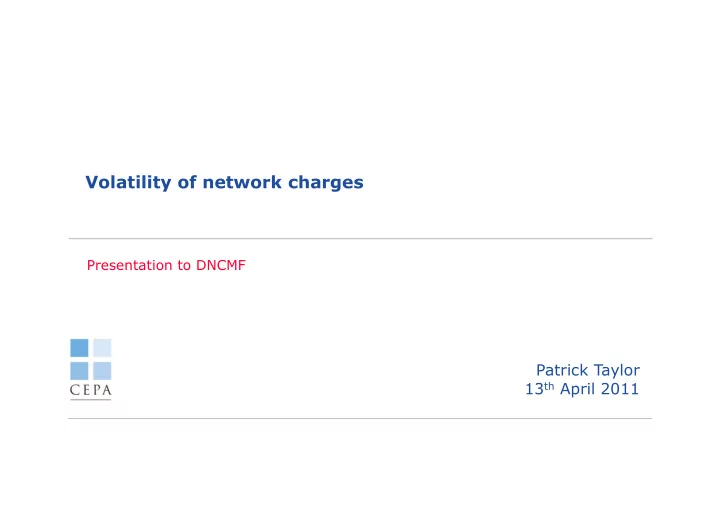

Volatility of network charges Presentation to DNCMF Patrick Taylor 13 th April 2011
Charging volatility a significant issue Volatility of network charges imposes high costs on consumers, who value stable, predictable prices Volatility also imposes high costs on network users: Charges impact on what level of costs they must seek to recover from their customers and their investment decisions Charging volatility recently highlighted as a barrier to entry in retail market (particularly detrimental to smaller players with less scope for managing risk within their portfolio) “Niche players… are exposed to disproportionate and unhedgeable risks in terms of the variability of Network Operator charges ... ... we either have to take the financial hit or pass through to our customers… [which] in our experience can be very damaging to a supplier reputation” Bizz Energy, August 2008 Centrica commissioned CEPA to review charging volatility and uncertainty issues in the context of RIIO-GD1 and RIIO-T1 * * http://www.ofgem.gov.uk/Networks/GasDistr/RIIO GD1/ConRes/Documents1/Centrica_Annex_2.pdf Page 1
Outline of the issue (1) CEPA’s paper sought to assess how network charging volatility is managed by different stakeholder groups Current regulatory perspective i. NWOs will always face uncertainties about appropriate outputs to deliver and around expenditure over the price control period ii. The most attractive option is to pass management of volatility of network charges through to final consumers and bills But final consumers value predictability in final bills - a “revealed willingness to pay” for predictability by entering into fixed price tariffs In a retail market where NWOs structure of charges may differ from suppliers, immediate full cost pass-though may also in reality not be achievable – often a temporal mismatch in cost recovery (e.g. different tariff periods) Under current arrangements it is consumers and often suppliers / market participants who are tasked with management of uncertainty and volatility of network charges Page 2
Outline of the issue (2) 2 Price control allows revenue If volatility in network charges is passed adjustments to flow to retail market through to final consumers there is no additional cost of managing NWO price Expected DUoS charges may differ setting volatility – although there may still 3 from outturn charges be a temporal mismatch in cost recovery. 1 But some consumers value stability and enter into forms of fixed price deals – a “revealed preference” and Ofgem sets price control. DUoS “willingness to pay” for predictability. charges used to set retail tariffs 4 Revenue adjustment Retail market / Final consumer NWO price control mechanisms suppliers Final consumers adopt fixed price tariffs and value predictable bills – suppliers Risk and management of uncertainty 6 tasked with managing volatility. passed to retail market “Opportunity cost” of working capital may be higher for final consumers compared 5 Under current arrangements suppliers (in a retail market) are often to retail suppliers. tasked with managing volatility of network charges. This is covered in Revealed by final consumers “willingness a non-NPV neutral manner often through insurance premiums applied to pay” the supplier to manage price and to network charges. Are there more efficient options for managing NWO charging volatility. the uncertainty and volatility of network charges? Page 3
Range of ‘top-down’ mechanisms available for consideration NWOs face uncertainty and incentive schemes to manage their businesses – clear regulatory rationale for revenue adjustment mechanisms Are there innovative approaches to help manage charging volatility and the impacts on consumers and stakeholders? Three high-level options set out in CEPA paper: Re-profiling Logging up Cap/collar Each tasks NWOs with managing volatility of DUoS charges and seeks to achieve full cost recovery by NWOs and increased predictability for suppliers/market participants Each can be done in an NPV neutral manner through licence cost recovery mechanism Direct benefits of more predictable prices and lower costs – if NWOs opportunity cost of working capital to manage volatility is lower than suppliers Indirect benefits (e.g. via competition and new retail entry) could be significant over the medium / longer term Page 4
Contact Details CAMBRIDGE ECONOMIC POLICY ASSOCIATES Queens House, 55-56 Lincoln’s Inn Fields London WC2A 3LJ Tel: 020 7269 0210 Fax: 020 7405 4699 patrick.taylor@cepa.co.uk Page 5
Recommend
More recommend